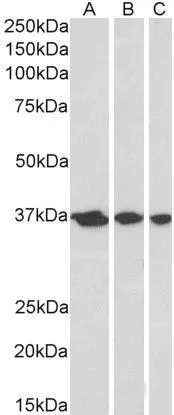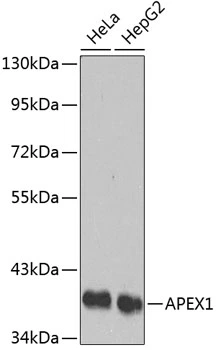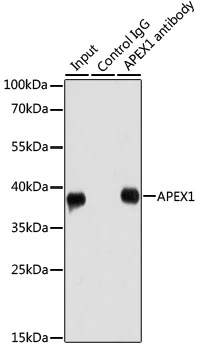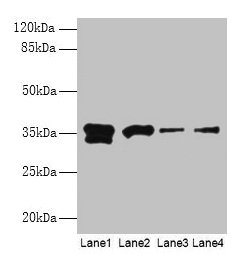APE1 antibody
GTX107122
ApplicationsWestern Blot, ImmunoHistoChemistry, ImmunoHistoChemistry Paraffin
Product group Antibodies
TargetAPEX1
Overview
- SupplierGeneTex
- Product NameAPE1 antibody
- Delivery Days Customer9
- Application Supplier NoteWB: 1:500-1:3000. IHC-P: 1:100-1:1000. *Optimal dilutions/concentrations should be determined by the researcher.Not tested in other applications.
- ApplicationsWestern Blot, ImmunoHistoChemistry, ImmunoHistoChemistry Paraffin
- CertificationResearch Use Only
- ClonalityPolyclonal
- Concentration1 mg/ml
- ConjugateUnconjugated
- Gene ID328
- Target nameAPEX1
- Target descriptionapurinic/apyrimidinic endodeoxyribonuclease 1
- Target synonymsAPE, APE1, APEN, APEX, APX, HAP1, REF1, DNA repair nuclease/redox regulator APEX1, AP endonuclease class I, AP lyase, APEX nuclease (multifunctional DNA repair enzyme) 1, DNA-(apurinic or apyrimidinic site) endonuclease, DNA-(apurinic or apyrimidinic site) lyase, apurinic-apyrimidinic endonuclease 1, apurinic/apyrimidinic (abasic) endonuclease, deoxyribonuclease (apurinic or apyrimidinic), protein REF-1, redox factor-1
- HostRabbit
- IsotypeIgG
- Protein IDP27695
- Protein NameDNA-(apurinic or apyrimidinic site) lyase
- Scientific DescriptionApurinic/apyrimidinic (AP) sites occur frequently in DNA molecules by spontaneous hydrolysis, by DNA damaging agents or by DNA glycosylases that remove specific abnormal bases. AP sites are pre-mutagenic lesions that can prevent normal DNA replication so the cell contains systems to identify and repair such sites. Class II AP endonucleases cleave the phosphodiester backbone 5 to the AP site. This gene encodes the major AP endonuclease in human cells. Splice variants have been found for this gene; all encode the same protein. [provided by RefSeq]
- Storage Instruction-20°C or -80°C,2°C to 8°C
- UNSPSC12352203
References
- Inhibition of hydrogen sulfide biosynthesis sensitizes lung adenocarcinoma to chemotherapeutic drugs by inhibiting mitochondrial DNA repair and suppressing cellular bioenergetics. Szczesny B et al., 2016 Nov 3, Sci RepRead more


![WB analysis of HeLa cell lysate using GTX20194 APE1 antibody [13B8E5C2].](https://www.genetex.com/upload/website/prouct_img/normal/GTX20194/GTX20194_1113_WB_w_23060620_341.webp)



